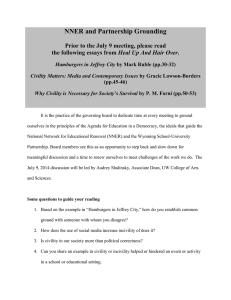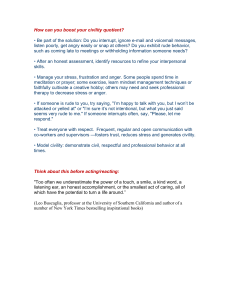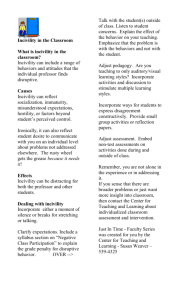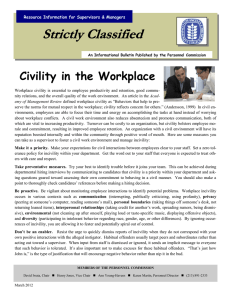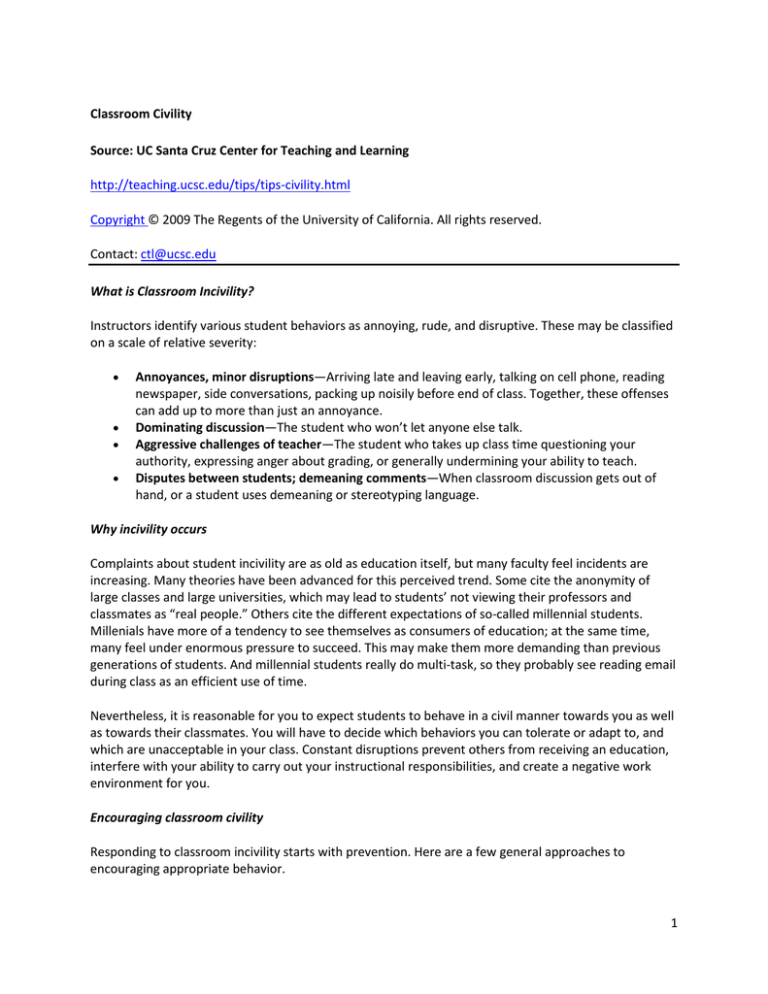
Classroom Civility
Source: UC Santa Cruz Center for Teaching and Learning
http://teaching.ucsc.edu/tips/tips-civility.html
Copyright © 2009 The Regents of the University of California. All rights reserved.
Contact: ctl@ucsc.edu
What is Classroom Incivility?
Instructors identify various student behaviors as annoying, rude, and disruptive. These may be classified
on a scale of relative severity:
•
•
•
•
Annoyances, minor disruptions—Arriving late and leaving early, talking on cell phone, reading
newspaper, side conversations, packing up noisily before end of class. Together, these offenses
can add up to more than just an annoyance.
Dominating discussion—The student who won’t let anyone else talk.
Aggressive challenges of teacher—The student who takes up class time questioning your
authority, expressing anger about grading, or generally undermining your ability to teach.
Disputes between students; demeaning comments—When classroom discussion gets out of
hand, or a student uses demeaning or stereotyping language.
Why incivility occurs
Complaints about student incivility are as old as education itself, but many faculty feel incidents are
increasing. Many theories have been advanced for this perceived trend. Some cite the anonymity of
large classes and large universities, which may lead to students’ not viewing their professors and
classmates as “real people.” Others cite the different expectations of so-called millennial students.
Millenials have more of a tendency to see themselves as consumers of education; at the same time,
many feel under enormous pressure to succeed. This may make them more demanding than previous
generations of students. And millennial students really do multi-task, so they probably see reading email
during class as an efficient use of time.
Nevertheless, it is reasonable for you to expect students to behave in a civil manner towards you as well
as towards their classmates. You will have to decide which behaviors you can tolerate or adapt to, and
which are unacceptable in your class. Constant disruptions prevent others from receiving an education,
interfere with your ability to carry out your instructional responsibilities, and create a negative work
environment for you.
Encouraging classroom civility
Responding to classroom incivility starts with prevention. Here are a few general approaches to
encouraging appropriate behavior.
1
Make expectations clear.
o
o
Write a statement for the syllabus, framed as positively as possible, communicating the
civil behavior you expect of students. Be sure to set aside some class time to go over the
statement. Click here to see several sample statements of classroom behavior.
In smaller classes, particularly those that involve a lot of discussion, you may wish to
have students as a group create the “rules of engagement.” Have them brainstorm
reasonable discussion and classroom behavior in groups, then get together to create a
document that has wide consensus. Be sure to print it and give a copy to each student.
Do your part to create a civil climate.
o
o
o
Treat students with respect. Treat them as adults. Respect their ability to learn. Avoid
sarcasm, dismissing their abilities, or making assumptions about them based on their
age, appearance, etc. Make it clear that you value them as individuals. You can’t expect
them to respect you and your classroom, if you don’t treat them with respect.
Establish a method for airing grievances. Set up a suggestion box or a comment space
on the course web site; gather mid-quarter feedback; ask for student volunteers to act
as liaisons; encourage TAs to pass along comments.
Reduce anonymity. Even in large classes, you can encourage students to get to know
one another and you. Visit section meetings, or schedule time for groups of students to
meet with you. Learn as many names as possible. Have students interact with
neighbors. Tell them something about yourself.
Responding to specific kinds of incivility
Creating a positive classroom climate and communicating expectations will help reduce uncivil
tendencies. But even with the best intentions, you will probably encounter students who just don’t get
the message. This section suggests specific preventive measures for each level of incivility, and how to
respond if it happens.
1. Annoyances, minor disruptions
a. Prevention--•
•
•
Publish behavior expectations in syllabus and on course web site (see above).
In a large class, have a designated area of the classroom near the door for late/early
students to sit.
In smaller classes, you could require notice in advance for any early departure.
b. If it happens--•
Initially, refer to the problem behavior in general, rather than calling attention to
specific offenders. (“It’s really hard to have a class discussion with side conversations
going on.” “Please don’t pack up yet. There is still 5 minutes of class and I intend to use
2
•
•
that time.” “I’m going to get started on lecture now, but first I need the newspapers put
away and cell phones turned off.”)
For persistent offenders, several options: (1) Pause and wait for students to become
quiet; if necessary, look at students who are talking. (2) Ask them to see you after class.
(3) Walk over close to where offense is occurring. (3) Ask a question of someone sitting
next to talkers/sleepers/newspaper readers, moving the discussion to that part of the
room. (4) Politely, not sarcastically, ask talkers to share with entire class. (5) Directly ask
the student(s) to stop the behavior (“Please put down that newspaper.”)
If someone is persistent and pointed in rude or disruptive behavior, see section 3c,
below.
2. Dominating discussion
These students probably don’t see themselves as “uncivil.” In fact, many are genuinely trying to help:
they can’t tolerate silences in discussion, and they perceive they are ‘rescuing” you from other students
not participating. Others, of course, simply have an inflated sense of their own importance.
a. Prevention--•
•
Use discussion-leading techniques that encourage more people to participate (see
Teaching Tips on Getting More out of Discussion.
Give discussion guidelines at the beginning of the term.
b. If it happens--•
•
•
•
•
•
“Thanks, [name]. I’d like to bring more people into this conversation. I’m going to ask
you to hold your comments for a while.”
Stop discussion, ask class to write briefly on the discussion topic, then call on people to
share what they’ve written.
Have 2 – 3 students act as “process observers” for a day. At the end of the class session,
have them report on their observations of how the discussion went, what problems they
noticed, and what suggestions they have.
If the problem persists, ask the student to see you after class so you can discuss the
issue privately. Try to keep it good-humored: you appreciate their eagerness and
involvement, but more learning will occur if more people participate.
In rare cases you may have to limit the discussion-dominator to 2 comments per class
meeting, give him/her tokens, or something like that.
If the discussion-dominator is aggressive or rude toward you or other students, see
sections 3 & 4.
3. Aggressive challenging of teacher
a. Prevention--•
This behavior may be difficult to prevent (but fortunately occurs rarely). Even faculty
who do everything they can to create a positive classroom climate may find themselves
3
•
faced with a student who has aggressive tendencies, is emotionally unstable, or for
some other reason is constantly challenging the teacher.
Sometimes students pick up on the insecurity of a newer teacher, and those with
bullying tendencies are inclined to take advantage of him/her. If you find you are subject
to frequent challenges to your authority, you may want to think about ways you can
behave in a more authoritative manner. Suggestions often include projecting your voice
more, moving around the room and using larger gestures, dressing somewhat more
formally to increase the “distance” between you and your students. Being very
organized and prepared also reduces students’ perceptions that you may be unsure of
yourself.
b. If it happens--•
•
•
•
•
•
•
Don’t get emotional. Try to get at the underlying issue as it relates to the class.
If it’s an individual issue (e.g., the student feels his test was graded incorrectly), ask
him/her to see you after class.
If the student is challenging your authority, knowledge of the subject, or ability to teach,
try to avoid a prolonged confrontation during class time. Tell the challenger this is not
an appropriate place for the discussion, and you will discuss it with him/her later.
If the challenge concerns wider issues that might affect other students (e.g., class
policies) you may want to ask the rest of the class whether this is an issue that is
concerning them as well. If it is, go ahead and have a class discussion about it, inviting
the others to express their views. If other students say it is not of concern to them,
point out to the student that it is an individual issue, and he/she can come see you
during office hours.
In any discussion outside of class, try to identify specific issues and stick with them.
Express interest in the student’s point of view, and be sure you give him/her a chance to
talk without interrupting. Try not to be defensive. Explain policies, grading, etc., but
don’t get into a long defense.
If you are wrong, try to admit it gracefully. . .the sooner the better. However, if you’re
feeling pressured, it’s legitimate to tell students you need time to think about the issue,
and you wish to return to it at the next class period.
For grade challenges, require students to put their reasons in writing. This gives
everyone a cooling off period, and communicates that your decisions will be based on
evidence, not emotion.
c. If the behavior is serious or repeated:
•
•
•
Don’t suffer in silence. Discuss the problem with your department chair or another
trusted colleague, and ask them to help you develop a plan for dealing with it. Other
campus resources that may be able to help include Counseling, Student Judicial Affairs,
the student’s college provost, or the Title IX/Sexual Harassment office.
Keep a written record of dates and what happened, as well as any witnesses. This will be
crucial if judicial action becomes necessary.
If you suspect the student has psychological/emotional problems, you can refer him/her
to Counseling Services.
4
•
•
If a student engages in repeated disruptive, challenging behavior, and the situation
cannot be resolved by the instructor and the department chair, the Campus Judicial
Officer should be notified.
If you feel a student poses an immediate threat to anyone in the room, call 911 to
summon campus police.
4. Disputes between students; demeaning comments
a. Prevention--•
See “Encouraging classroom civility,” above.
b. If it happens--•
•
•
•
Remind students of classroom rules for respectful behavior.
State very clearly that you will not tolerate demeaning comments, especially those
based on race, gender, or sexual orientation.
If appropriate, you can offer the offending student a graceful way to backtrack. Say, “I
think many of us interpret what you said as meaning x. Is that what you meant?” or “It
sounds like you’re attacking Joe personally. Can you restate your views so that you’re
addressing the issue?” Then remind students that you know they sometimes get
passionate about issues, but that they must keep their comments constructive and
avoid personal attacks.
Stop discussion and ask all students to write briefly about what just happened, and what
they think should be done about it. Depending on the situation, you may then call for
discussion, or ask students to anonymously turn in their writing, and you will share their
thoughts with the class.
Additional resources
Successful Beginnings for College Teaching, by Angela Provitera McGlynn (Atwood, 2001).
LB2331 .P768 2001
This book provides excellent ideas for creating a positive classroom climate and getting students
jointly engaged in learning. It includes a chapter on “Dealing with Incivility in the College Classroom.”
Engaging Large Classes, ed. Christine A. Stanley and M. Erin Porter (Anker, 2002).
See esp. Ch. 4, “Promoting Civility in Large Classes,” by Mary Dean Sorcinelli.
McKeachie’s Teaching Tips, 11th ed., by Wilbert J. McKeachie (Houghton Mifflin, 2002).
See Ch. 11, “Problem Students (There’s Almost Always at Least One!)”
Web site on Classroom Management
http://www.4faculty.org/includes/108r2.jsp
The Chronicle of Higher Education (1998) -- Colloquy: Is rudeness on the rise?: Responses
http://chronicle.com/colloquy/98/rude/re.htm
5
Sample civility statements for syllabi
Adapt these according to your preferences and to fit the type of class you are teaching.
#1 Civility in the classroom and respect for the opinions of others is very important in an academic
environment. It is likely you may not agree with everything which is said or discussed in the classroom.
Courteous behavior and responses are expected.
#2 To create and preserve a classroom atmosphere that optimizes teaching and learning, all participants
share a responsibility in creating a civil and non-disruptive forum. Students are expected to conduct
themselves at all times in this classroom in a manner that does not disrupt teaching or learning.
•
You are expected to be on time. Class starts promptly at x. You should be in your seat and ready
to begin class at this time. Class ends at x. Packing up your things early is disruptive to others
around you and to myself.
•
Classroom participation is a part of your grade in this course. To participate you must attend
class having prepared the materials for the day. Questions and comments must be relevant to
the topic at hand.
•
Raise your hand to be recognized.
•
Classroom discussion should be civilized and respectful to everyone and relevant to the topic we
are discussing. Classroom discussion is meant to allow us to hear a variety of viewpoints. This
can only happen if we respect each other and our differences.
•
Any discussion from class that continues on any listserv or class discussion list should adhere to
these same rules and expectations.
•
Electronic devices such as cell phones and pagers must be turned off during class, unless you
have informed me ahead of time that you are expecting an emergency message.
#3 The classroom is a special environment in which students and faculty come together to promote
learning and growth. It is essential to this learning environment that respect for the rights of others
seeking to learn, respect for the professionalism of the instructor, and the general goals of academic
freedom are maintained. Differences of viewpoint or concerns should be expressed in terms which are
supportive of the learning process, creating an environment in which students and faculty may learn to
reason with clarity and compassion, to share of themselves without losing their identities, and to
develop an understanding of the community in which they live. Student conduct which disrupts the
learning process shall not be tolerated and may lead to disciplinary action and/or removal from class.
#4 Any successful learning experience requires mutual respect on the part of the student and the
instructor. Neither instructor nor student should be subject to others’ behavior that is rude, disruptive,
intimidating, or demeaning. The instructor has primary responsibility for and control over classroom
behavior and maintenance of academic integrity.
6
Instructor responsibilities:
•
•
•
•
Start and end class on time.
Treat all students with courtesy and respect.
Be open to constructive input from students in the course.
Ensure that opportunities to participate are enjoyed equally by all students in the course.
Student responsibilities:
•
•
•
•
Come to class on time, and refrain from packing up belongings before class ends.
Turn off all electronic devices that might create a disruption in class.
Be quiet and give full respectful attention while either instructor or another student is speaking.
When speaking, use courteous, respectful language and keep comments and questions relevant
to the topic at hand.
7

